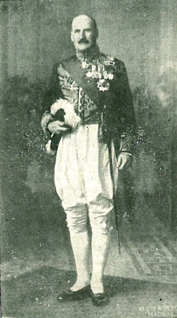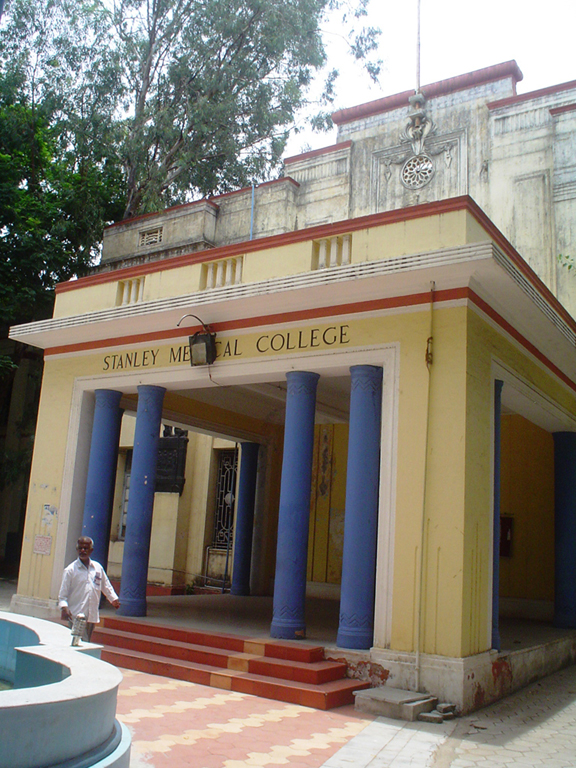|
(Continued from last fortnight)

Sir George Stanley.
|
The predecessor of Stanley Medical College was the Royapuram Medical School that was started in June 1903 as a small school housed in the Old Bullet Factory of the East India Company. Between 1910 and 1920, Government started medical schools in Calicut, Vizagapatam and Tanjore to make medical knowledge available to more people. But inefficiency and ill-equipped establishments resulted in all those schools, except the one in Royapuram, being closed down.
When the five-year LMP course was inaugurated on March 27, 1934 by the then Governor of Madras Presidency, Sir George Fredrick Stanley, the college, till then known as Royapuram Medical School, was renamed Stanley Medical School in his honour.
Dr. V.C. Sudarsanam, Hon. Ophthalmic Surgeon (with more than 33 years of service at Stanley from September 1930, and who had studied in the school before joining Madras Medical College in 1934), remembers joining Royapuram Medical School in 1920 to get a diploma to practise medicine, surgery and midwifery as a Licensed Medical Practitioner (LMP). He says, "Students who joined then had just finished high school and were from various parts of the then Madras Presidency. School work started as early as 7 a.m. and, twice a week, we had to attend physical instruction class held in the ground behind what is now the ladies' hostel blocks. At the appointed hour, correct to the minute, we lined up and by that time the Superintendent, an IMS officer, would come riding on his horse, sometimes in uniform, and inspect us. Col. Bryson would pick out all coats without buttons, shoes without socks, open coats without tie, a tuft without a turban, and unshaven faces and those so identified were ordered to be at his office after class work was over. The next inspection was outstretched palms. All palms felt soft would be sent to the Gym instructor with orders for practice on various bars; others would do marching and physical exercises."
Lecturers and teachers were "very keen on maintaining discipline." When students failed to pay tuition fees or exam fees on time, each would be questioned by the Superintendent in private and in genuine cases of poverty, he often paid from his own pocket! The Senior Anatomy class was taken by the then Chief Lecturer, Dr. S. Swaminatha Pillay, assisted by Dr. Sivasubramaniam. Their treatment of the subject was "something marvellous, we thought we were reading Arabian Nights!". Pathology was taught in the third year by Dr. C. Chinnaswamy Pillai, who was interested in many subjects and who was a voluminous reader and constructive critic. Third year students were posted in the pathology department and would start the day at 7 a.m.

Stanley Medical College.
|
"All urine, blood, stools examinations had to be done by students who were assisted by an Assistant Lecturer. All examinations had to be conducted in his immediate presence. Every finding was recorded in separate sheets and had to be ready before the lecturer arrived at 9 a.m. After we read reports, we were asked to write on the blackboard, and handwriting checked for formation of dots, dashes, spellings, punctuation, etc. Post-mortem classes were very illuminating and description of findings had to be accurate. All measurements were made correct to the tenth of an inch, including the length and breadth of intestinal worms! Dr.V. Kalyanaraman, assisted him ably. Methodical work was emphasised, test tubes and slides washed, microscopes cleaned and covered, and the number of match sticks used to be counted before we left class!", he further recalled.
Dr. Sudarsanam talks of two giants, Dr. S.M. Trasi, whose way "of putting sutures was so quick and correct that both hands worked like a machine", and his assistant, Dr. N.S. Narasimha Iyer. "The hospital had a very pleasant look, neat with well-laid out gardens and plenty of breathing spaces in between wards. Stanley was the first among all the medical colleges in the city to create a garden. Dr. P.F. Mathias, the Superintendent, was very focussed on cleanliness. After hostel rounds, there were rounds of hospital gardens, where every nook and corner was inspected. Every wall in the wards would be examined by the Superintendent and touched to see if they were dirty!" He remembers that once, when the Superintendent Lt. Col. D.G. Rai was doing his rounds in the Willingdon Ward, the floors made of Italian marble were kept so clean and polished that he slipped and fell with a bang. He got up smiling though!"
A milestone in the annals of the institution was the upgradation of Stanley Medical School to Stanley Medical College in 1938 and also the introduction of the five-year undergraduate course in Medicine and Surgery. Dr. T.S.S. Rajan, an alumnus of Stanley, who held the medical portfolio in the first Congress Government of Madras Province, inaugurated the event on July 2, 1938. Admission to the DMS course was discontinued a short while later and the college was affiliated to Madras University. The birth pangs were many and varied for the first batch of 72 students. There was no college building ready and preclinical teachings in Anatomy, Physiology, Biochemistry and Organic Chemistry were done at Madras Medical College. The best outgoing student of the first batch was Dr. T.S. Kalyanam, an outstanding student whose tally of medals was unrivalled in the Madras Presidency!
In 1941, three medical and surgical units were created. Permission to start MD and MS courses was given in 1948. By 1950, the College became independent of Madras Medical College. When the new Anatomy and Physiology Departments were inaugurated in the new college building (built at a cost of Rs.9.5 lakh), it became a full-fledged college offering facilities for training students in all subjects of the medical curriculum. The number of students admitted increased from 72 to 100. There was also an additional increase of 10 students to help Licentiate D M and S to undergo condensed course before graduation.
By 1952, the Department of Anatomy was upgraded with courses for M.Sc and Ph. D in Anatomy. The intake capacity was 4 per year, chosen from among students from all over India. The institution of a Dean to administer both the College and Hospital was created the same year. The first Dean was Dr. Ananthanarayana Iyer who established the Institute of Anatomy at Stanley in 1955, attracting students from all over the country. He also established the Anatomy Society of India in 1955 as a platform for research and dissemination of information on developments in anatomy at the annual conferences.
Four years later, a major addition to SMC was the newly constructed (at a cost of Rs.32 lakh) Raja Sir Ramaswami Mudaliar Lying-In Hospital with 275 beds. By January 1963, annual admission rose to 150. There were by then seven medical and surgical units.
In a unique gesture in the history of government institutions, old students and former and the then-working staff of SMC generously contributed Rs.1 lakh towards construction of the auditorium for the College. The Chief Minister of Madras, M. Bhaktavatsalam, accepted the amount and sanctioned another Rs.5 lakh for the auditorium. The foundation stone was laid by the then President of India , Dr. Sarvepalli Radhakrishnan, on October 30, 1964, as a part of its Silver Jubilee celebrations.
"The whole campus of the institution, comprising college, hospitals and hostels extend over 3 square furlongs or 27 acres of land, unfortunately cut across by a busy road and surrounded by shrieking multitudes of railway engines, over which even the Central Minister of Transport appears to have no control," stated a note from Dr. K.C. Nambiar at that time.
Dr. A.N.K. Menon, Dean, Stanley Medical College and ex-officio Vice Chairman of the Silver Jubilee Committee, recorded: "What started as a medical school in 1903 in the Bullet Factory of the East India Company has now grown into a full-fledged Medical College giving training to both UG and PG and occupying a remarkably high place in medical colleges in India. The attached teaching hospital which started in 1790 as a Native Infirmary with 75 beds has developed into a magnificent modern teaching hospital accommodating thousands of patients with facilities for special treatment in all branches. At present, the College has on its roll about 1120 students with 150 undergraduates taken in every year. At the inauguration of the Silver Jubilee celebrations, a magnificent three-floor OP block will be opened, and will be one of the best equipped and spacious OP blocks in India, if not in South-East Asia."
In the Diamond Jubilee Souvenir of the SMC (1963), M. Bhaktavatsalam, the then Chief Minister, wrote, "When the Royapuram Medical School was started 60 years ago, the area in which the school was located was girdled by palms and groves and fields. Today, the city has grown vastly and in all the three directions. The Medical School too has grown and developed into the Stanley Medical College. The palm groves and fields that once surrounded this area have gone and in their place stand factories, big and small. Institutions which serve people grow with the growing population.
It is a matter of pride that Stanley Medical College, which completes 25 years of life this year, has been able to send out every year medical men who go out to heal the sick and the wounded in different parts of the State."

Dr. T.S. Tirumurthi – first Indian
principal of the Medical College.
|
Stanley Medical College's early rolls had many medical luminaries and administrators, like Dr. T.S. Tirumurthi, the first Indian principal; Dr. Dinkar Rau, wonderful teacher and principal; Dr. David, the first Professor of Pharmacology and the author of one of the earliest textbooks on the subject; Dr. Anantha-narayana Iyer, the well known Professor of Anatomy; Dr. R. Mahadevan, eminent surgeon who performed the first mitral valvotomy in the country; Dr. R. Raghavachari, legendary surgeon and exemplary teacher who operated on Shri Ramana Maharshi for cancer in the forearm; Dr. Kuttumbiah, well known physician; Dr. Mannadi Nair, the first Professor of Biochemistry in Madras Presidency; Dr. R.G. Krishnan, obstetrician and gynaecologist, who made the outpatient departments and clinical services at the hospital more effective; Dr. M. Natarajan, renowned orthopaedic surgeon, and teacher; Dr. M. Vishwanathan, well-known diabetologist; Dr. Natesa Mudaliar, professor of venereology and an excellent teacher; and well-known physician, Dr. Rathnavel Subramanian, and many others!
(To be continued)
- A peaceful students' strike in 1920 resulted in "two important reliefs". Till then, if a student failed in the final year three times, he was "dismissed and career ended". Students had to secure 80 per cent attendance and pass in the selection exam before being sent up for the Board Exam every year. After the strike, the practice of detention by selection exam and dismissal after three failures was stopped!
- The very first student journal of the institution, issued in March 1933, was called The Royapuram Medico!
|